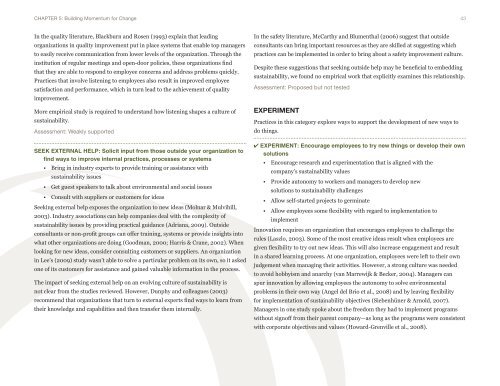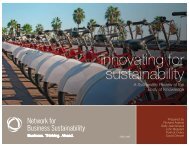embedding sustainability in organizational culture - Network for ...
embedding sustainability in organizational culture - Network for ...
embedding sustainability in organizational culture - Network for ...
You also want an ePaper? Increase the reach of your titles
YUMPU automatically turns print PDFs into web optimized ePapers that Google loves.
Chapter 1: 5: Introduction Build<strong>in</strong>g Momentum <strong>for</strong> Change<br />
43<br />
In the quality literature, Blackburn and Rosen (1993) expla<strong>in</strong> that lead<strong>in</strong>g<br />
organizations <strong>in</strong> quality improvement put <strong>in</strong> place systems that enable top managers<br />
to easily receive communication from lower levels of the organization. Through the<br />
<strong>in</strong>stitution of regular meet<strong>in</strong>gs and open-door policies, these organizations f<strong>in</strong>d<br />
that they are able to respond to employee concerns and address problems quickly.<br />
Practices that <strong>in</strong>volve listen<strong>in</strong>g to employees also result <strong>in</strong> improved employee<br />
satisfaction and per<strong>for</strong>mance, which <strong>in</strong> turn lead to the achievement of quality<br />
improvement.<br />
More empirical study is required to understand how listen<strong>in</strong>g shapes a <strong>culture</strong> of<br />
<strong>susta<strong>in</strong>ability</strong>.<br />
assessment: Weakly supported<br />
SEEk ExtERnal hElp: Solicit <strong>in</strong>put from those outside your organization to<br />
f<strong>in</strong>d ways to improve <strong>in</strong>ternal practices, processes or systems<br />
• Br<strong>in</strong>g <strong>in</strong> <strong>in</strong>dustry experts to provide tra<strong>in</strong><strong>in</strong>g or assistance with<br />
<strong>susta<strong>in</strong>ability</strong> issues<br />
• Get guest speakers to talk about environmental and social issues<br />
• Consult with suppliers or customers <strong>for</strong> ideas<br />
Seek<strong>in</strong>g external help exposes the organization to new ideas (Molnar & Mulvihill,<br />
2003). Industry associations can help companies deal with the complexity of<br />
<strong>susta<strong>in</strong>ability</strong> issues by provid<strong>in</strong>g practical guidance (Adriana, 2009). Outside<br />
consultants or non-profit groups can offer tra<strong>in</strong><strong>in</strong>g, systems or provide <strong>in</strong>sights <strong>in</strong>to<br />
what other organizations are do<strong>in</strong>g (Goodman, 2000; Harris & Crane, 2002). When<br />
look<strong>in</strong>g <strong>for</strong> new ideas, consider consult<strong>in</strong>g customers or suppliers. An organization<br />
<strong>in</strong> Lee’s (2009) study wasn’t able to solve a particular problem on its own, so it asked<br />
one of its customers <strong>for</strong> assistance and ga<strong>in</strong>ed valuable <strong>in</strong><strong>for</strong>mation <strong>in</strong> the process.<br />
The impact of seek<strong>in</strong>g external help on an evolv<strong>in</strong>g <strong>culture</strong> of <strong>susta<strong>in</strong>ability</strong> is<br />
not clear from the studies reviewed. However, Dunphy and colleagues (2003)<br />
recommend that organizations that turn to external experts f<strong>in</strong>d ways to learn from<br />
their knowledge and capabilities and then transfer them <strong>in</strong>ternally.<br />
In the safety literature, McCarthy and Blumenthal (2006) suggest that outside<br />
consultants can br<strong>in</strong>g important resources as they are skilled at suggest<strong>in</strong>g which<br />
practices can be implemented <strong>in</strong> order to br<strong>in</strong>g about a safety improvement <strong>culture</strong>.<br />
Despite these suggestions that seek<strong>in</strong>g outside help may be beneficial to <strong>embedd<strong>in</strong>g</strong><br />
<strong>susta<strong>in</strong>ability</strong>, we found no empirical work that explicitly exam<strong>in</strong>es this relationship.<br />
assessment: proposed but not tested<br />
experiment<br />
Practices <strong>in</strong> this category explore ways to support the development of new ways to<br />
do th<strong>in</strong>gs.<br />
✔ ExpERiMEnt: Encourage employees to try new th<strong>in</strong>gs or develop their own<br />
solutions<br />
• Encourage research and experimentation that is aligned with the<br />
company’s <strong>susta<strong>in</strong>ability</strong> values<br />
• Provide autonomy to workers and managers to develop new<br />
solutions to <strong>susta<strong>in</strong>ability</strong> challenges<br />
• Allow self-started projects to germ<strong>in</strong>ate<br />
• Allow employees some flexibility with regard to implementation to<br />
implement<br />
Innovation requires an organization that encourages employees to challenge the<br />
rules (Laszlo, 2003). Some of the most creative ideas result when employees are<br />
given flexibility to try out new ideas. This will also <strong>in</strong>crease engagement and result<br />
<strong>in</strong> a shared learn<strong>in</strong>g process. At one organization, employees were left to their own<br />
judgement when manag<strong>in</strong>g their activities. However, a strong <strong>culture</strong> was needed<br />
to avoid hobbyism and anarchy (van Marrewijk & Becker, 2004). Managers can<br />
spur <strong>in</strong>novation by allow<strong>in</strong>g employees the autonomy to solve environmental<br />
problems <strong>in</strong> their own way (Angel del Brio et al., 2008) and by leav<strong>in</strong>g flexibility<br />
<strong>for</strong> implementation of <strong>susta<strong>in</strong>ability</strong> objectives (Siebenhüner & Arnold, 2007).<br />
Managers <strong>in</strong> one study spoke about the freedom they had to implement programs<br />
without signoff from their parent company—as long as the programs were consistent<br />
with corporate objectives and values (Howard-Grenville et al., 2008).
















